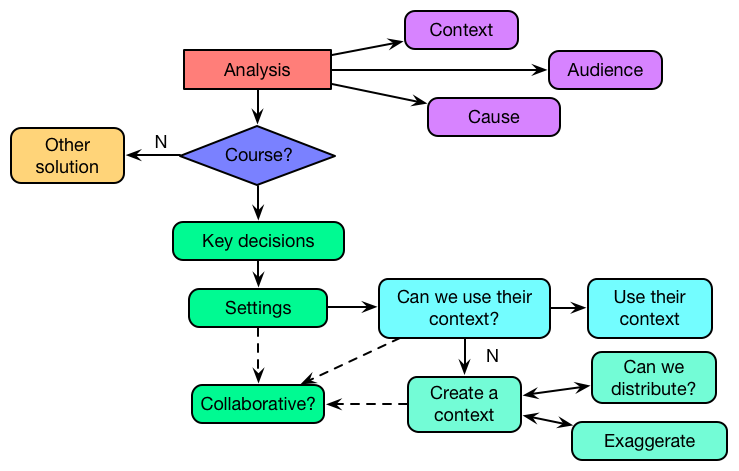I was talking to the ADL Mobile folks about mobile design processes, and as usual I was going on about how mobile is not the sweet spot for courses (augmenting yes, full delivery no). When tablets are acting more like a laptop, sure, but otherwise. I had suggested that the real mobile opportunities are using sensors to do contextual things, and and I also opined that we really don’t have an instructional design model that adequately addresses taking context into account. I started riffing on what that might involve, and then continued it on a recent trip to speak in Minneapolis.
 Naturally, I started diagramming. I am thinking specifically of augmenting formal learning here, not performance support. In this diagram, when it’s not a course you head off to consider contextual performance support, if indeed the context of performance is away from a computer.
Naturally, I started diagramming. I am thinking specifically of augmenting formal learning here, not performance support. In this diagram, when it’s not a course you head off to consider contextual performance support, if indeed the context of performance is away from a computer.
When, however, it is a course, and you start embedding the key decisions into a setting, the first thing you might want to do is use their existing context (or contexts, it occurs to me now). Then we can wrap learning around where (or when) they are, turning that life event into a learning experience. Assuming, of course, we can detect and deliver things based upon context, but that’s increasingly doable.
Now if you can’t use their context, because it’s arguably not something that is located in their existing lives, we want to create a context (this is, really, the essence of serious game design). It might be fantastic (some conspiracy theory, say) or very real (e.g. the Red 7 sales demo, warning: large PDF), but it’s a setting in which the decisions are meaningfully embedded (that is, real application of the model and of interest to the learner). It might be desktop but if possible, could we distribute the experience into the learners’ world, e.g. transmedia? Here we’re beginning to talk Alternate Reality Game. (And we use exaggeration to ramp up the motivation.)
As an aside, I wondered when/how collaboration would fit in here, and I don’t yet have an answer: before setting, after, or in parallel? Regardless, that’s definitely another consideration, which may be driven by a variety of factors such as whether there are benefits to role-play or collaboration in this particular instance.
This is still very preliminary (thinking and learning out loud), but it has some initial resonance to me. For you too, or where am I going off track?
Leave a Reply